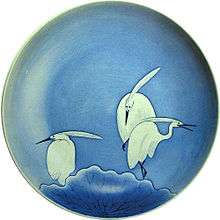Bizen ware

Bizen ware (備前焼 Bizen-yaki) is a type of Japanese pottery most identifiable by its significant hardness, reddish brown color, absence of glaze (though there can be traces of molten ash looking like glaze), and markings resulting from wood-burning kiln firing.
Bizen is named after the village of Imbe in Okayama prefecture, formerly known as Bizen province. This artwork is Japan's oldest pottery making technique, introduced in the Heian period. Bizen is one of the six remaining kilns of medieval Japan.
Bizen clay bodies have a high iron content and, traditionally, much organic matter that is unreceptive to glazing. The clay can take many forms.

The surface treatments of Bizen wares are entirely dependent on yohen, or "kiln effects." Pine ash produces goma, or "sesame seed" glaze spotting. Rice straw wrapped around pieces creates red and brown scorch marks. The placement of pieces in a kiln causes them to be fired under different conditions, with a variety of different results. Although one clay body and type of firing is used there is a wide variety of results.
Because of the clay composition, Bizen wares are fired slowly over a long period of time. Firings take place only once or twice a year. They require the wood fire to be kept burning for 10–14 days.
-

-

-
Komainu "a" style
-
Komainu "un" style
References
- Wilson, Richard L. Inside Japanese Ceramics. Weatherhill, New York and Tokyo, Second Edition 2005. ISBN 0-8348-0442-5
External links
| Wikimedia Commons has media related to Bizen ware. |
- e-yakimono.net
- Handbook for the Appreciation of Japanese Traditional Crafts
- Bizenyaki (Bizen ware) by Bifu Kimura - 'Kibido'
- Bizen Gallery Aoyama in English and Japanese
- Yakimono Gallery in Japanese and French
- Momoyama, Japanese Art in the Age of Grandeur, an exhibition catalog from The Metropolitan Museum of Art (fully available online as PDF), which contains material on Bizen ware
| ||||||||||
|

